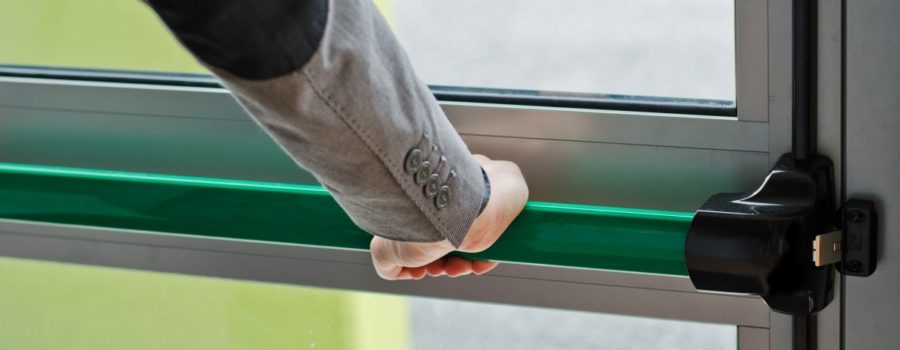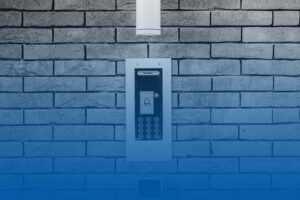Commercial Doors and Exit Devices
An “exit device” may sound like an intricate mechanism, but you’ve certainly seen examples of it any time you’ve used a push bar to open a door. As the name implies, exit devices are the category of products that provide swift egress from a space. These products are also often called panic hardware because they exist to prevent major issues in the event of an emergency or widespread panic. Basically, these are devices that make it easy to open a door quickly so that people can escape if, say, a business is on fire.
When your contractor starts talking to you about adding exit devices, they are not just trying to increase their bottom line. The vast majority of businesses are required by law to have some kind of exit device in place on all exits and many interior doors. While requirements may vary from one city or state to the next, the general legal requirement is that any building which can house 50 or more people must have exit devices on exits for safety purposes. They’re also explicitly required for all education and assembly spaces, regardless of size.
There are a couple of general requirements for business exits. First, they have to open outward. This is because people generally fail to think logically during emergencies, especially when there are crowds involved. There have been instances of crowd panic before that have resulted in injury and death because the doors opened inward and the crowd pressed into the exits too quickly and too forcefully to be able to pull the doors open. In addition to opening outward, the second requirement is that exits need to provide “single-press egress” so that no one has to stop and spend time having to figure out how to use the device. This is why the most common exit device is a push bar; even in a panicking crowd, if someone is pressed against the door, the door will simply open and free the crowd to flow out of the space.
Exit Devices and Security
Push bars, touch bars, deadlatch paddles, crossbars, and other exit devices are all great options for getting your customers and employees out quickly and safely in the event of an emergency. There are options that fit on pretty much every door style, too, so you can meet safety requirements without needing a full-scale door replacement.
However, if you’re at all security-minded, you may have picked up on one common concern that many business owners have, and that is the question of what happens when an opportunistic burglar tries to make off with your property? In theory, it’s just as easy for a robber to grab some of your goods and run through a door with a panic bar as it is for panicking people to escape in emergency situations. Fortunately, exit device designers have thought of that.
Securing Your Exit Device-Controlled Doors
It is entirely counter-productive to be able to lock or secure exit devices. However, there are a couple of ways to secure your space and slow burglars while still keeping customers and employees safe. For one thing, exit devices are generally only accessible from the inside. There is no corresponding exterior door handle, and if there is, it can generally be secured separately with the appropriate commercial door lock (though, of course, still opened from the inside).
There are also a range of different delayed-exit egress options. This is the subset of exit devices that delay for 15 seconds or more, even after the exit device is pressed. It may sound counter-intuitive, but these devices are well within legal requirements — though, in some occupancies, they must also be connected to a secondary safety system like a sprinkler system. A delayed-egress exit device is great in particular for retail and similar businesses because it can give security the chance to catch a shoplifter, but won’t go so far as to inhibit safety in the event of a fire or similar emergency.
Keeping your business up to code doesn’t need to become a security risk. Connect with your local locksmith team, Urich Lock, for experienced guidance across Milwaukee. Give us a call today to get started!





